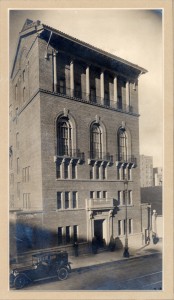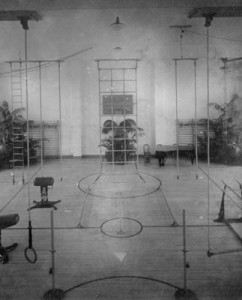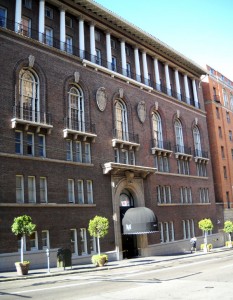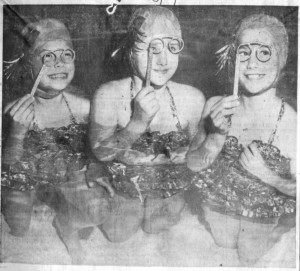Timeline
A brief history of the Club and Foundation:
1912
- Elizabeth Taylor Pillsbury visits the newly completed Woman’s Athletic Club of Chicago.
1912 – 1914
- A small group of Bay Area women meet to consider the idea of a
- Woman’s Athletic Club in San Francisco.
1914
- The charter membership of the Woman’s Athletic Club of San Francisco is recruited with seventeen women named as Founding Members. The prominent architectural firm of Bliss & Faville is engaged to draw up preliminary plans.
1915
- The Woman’s Athletic Club of San Francisco is incorporated on October 25, 1915 for a fifty year term. Pillsbury is its first president. The Club’s first official board meeting takes place on October 27, 1915 at the nearby Franciscan Club.
1915 – 1916
- Construction begins on the original facility at 640 Sutter Street. Building permit for a seven-story building states a cost of $95,000.

1917
- Clubhouse completed at a cost of $160,000. Membership is 1,000.
- First Board of Directors’ meeting is held at the Club on January 15, 1917.
- Opening reception takes place on February 4, 1917 attended by the mayor of San Francisco, heads of the athletic departments of Stanford and the University of California, the president and regents of the University of California, directors of clubs around the bay and the president of the YMCA. Press coverage notes the Club’s hydro-therapeutic baths, long rows of shampooing rooms, crystal clear swimming pool, tennis and handball courts, and “corrective gymnastics” at $2.00 per hour.
- Club signs a contract with the Olympic Salt Water Company to pump water to the swimming pool from Ocean Beach.
- On November 20, 1920, a $500,000 bond issue at 6% finances a major addition to 640 Sutter Street to meet the strong demand for Club usage. Thirty-four members eventually forgive their bonds and retire the Club’s debt.
1922
- Construction on major new addition begins in September led by the Club’s second president, Edna Barnard Black.
1923
- Expanded club reopens on December 26, 1923 with a membership of 2,000 women.
1925
- Vacant lot adjacent to the Club on the west is purchased for $78,788.17. Members are assessed $60 each to finance the purchase.
1930
- Census lists thirty-five people living in the Club. The Club continues to provide full-time residence rooms to members until the late 1980s.
1935
- The Club-owned vacant lot adjacent to 640 Sutter Street is leased for the first time since its 1925 purchase to operate as a parking lot after various proposals including miniature golf and putting greens are discarded.
1938
- A remodeling project creates the Kakemono Lounge on the first floor which opens on December 15, 1938. It is later renamed the Rendezvous Cocktail Lounge.
1941
1945
- By arrangement with the San Francisco Press and Radio Women’sCommittee, and at the request of the United Nations, the Club serves as the
- unofficial headquarters for the visiting women of the press.
- Barbara Jensen, a junior Club member, sets the American record in the 100 meter backstroke.
1947-48
- Board of Directors creates a Long Range Planning Committee, assisted by architect Joseph Esherick.
1948
- The Club is the only local club represented at the first Western meeting of UNESCO.
- Five members of the U.S. Olympic swimming team are made honorary members of the Club.
1953
- The first television is installed at the Club in a card room on the sixth floor. The first floor lounge is converted to the library and the lounge is moved to the fourth floor closer to the dining room.
1955
- Club celebrates its 40th anniversary with a luncheon and fashion show.
1965
- Original gymnasium on the second floor is converted to a meeting room.

- Woman’s Athletic Club incorporation of 1915 expires.
1966
- Club name is changed to the Metropolitan Club and re-incorporated with the same purposes as the original club. Of the 1,066 members at the time of the election, 688 vote in favor of the name change, 184 vote against, and 20 vote for a change to other unspecified names.
1979
- Parapet is reinforced according to plans by Peter Culley & Associates.
1987
- New shower rooms are built on the first floor at the cost of $101,000.
1989
- An upgrade to the first floor Fitness Center costs $250,000.
1990 – 1992
- The Club thoroughly considers and responds to new local & national anti-discrimination legislation by conforming to “strictly private” guidelines. It remains a club for women only.
1999
- McMahon Group, Inc. is hired to conduct focus groups and a membership survey. From the results, the Board identifies key issues including Membership Recruitment and Retention, Governance, Membership Benefits, Master Planning, Hours of Operation and Communication.
- The KSD Group is hired to prepare a facility needs assessment and master plan.
2001
- An Ad-hoc Action Planning Committee addresses the issues identified in the membership survey, develops mission and vision statements and makes specific recommendations to the Board of Directors.
- Building Planning Committee is appointed and begins work on a building master plan.
2003
- Long Range Planning Committee has its first meeting on January 17, 2003 to explore the benefits of nominating the Metropolitan Club to the National Register of Historic Places for both its historic and architectural significance. The Committee is also charged with determining the feasibility of establishing a 501(c)3 foundation to raise tax-deductible funds for the preservation of the historic clubhouse.
2004
- 640 Heritage Preservation Foundation is incorporated and receives its initial tax exempt ruling from the Internal Revenue Service and the Franchise Tax Board of California.
- Historian Michael Corbett is hired to research and prepare the Woman’s Athletic Club’s National Register of Historic Places nomination under Criterion A for significant events and under Criterion C for distinctive architecture. In September 2004, the nomination is approved by the Keeper of the Register, U.S. Department of the Interior.
- Capital Campaign Steering Committee is formed to assess the Club’s fundraising potential. Dohrmann & Associates is retained as fundraising counsel.
- The Pre-Construction Committee succeeds the Building Planning Committee to develop the Renovation Project scope and budget and build the professional team.
- Club Membership votes on June 24, 2004 to approve the Renovation Project funding plan that comprises a Member assessment, use of Club reserves, a loan of up to $3.7 million and raising $3 million in tax deductible donations. Renovation Project includes seismic and life safety upgrades such as sheer walls, micropiles and the installation of a new fire-rated exit stairwell in the atrium between the 1915 and 1923 buildings.
- “The Stewardship Campaign: Preserving The House That Women Built for a Second Century” officially begins its five year effort to raise funds for the renovation project.
- Members are assessed $2,900 each (adjusted for membership categories) to fund a portion of the renovation.
2005
- The Club celebrates its 90th anniversary with an original play written and performed by members, a celebration luncheon and black tie dinner.

- Stewardship Campaign reaches the $1 million milestone in funds raised by early December 2005.
2006
- The Elizabeth Pillsbury Society is formed to honor individuals who have named the Club or the Foundation in their estate plans and the first annual reception takes place.
2007
- The Pre-Construction Committee is replaced by the Building Construction
- Committee. Comprised of Club president, immediate past president and the general manager, it meets weekly with the professional team for the duration of construction.
- A construction loan for $6 million and a $2 million line of credit for the
- Renovation Project are obtained and a construction contract is signed.
- Construction begins with basement demolition on June 27, 2007.
- The pool closes in September and the Olympic Club extends privileges to Metropolitan Club swimmers until pool reopens.
2008
- 640 Heritage Preservation Foundation sponsors the Landmark Gala, an elegant dinner dance and auction at the Julia Morgan Ballroom in the Merchants Exchange Building on November 6, 2008, to raise funds for the Renovation Project.
2009
- Pool reopens on February 20, 2009 with a festive champagne reception. Long-time member swimmers, Betty Lampen and Sue Paul, cut the
- ribbon. Two junior members take the first swim. The newly-renovated fitness center and cabana/locker areas open on August 3, 2009.
- “Last Peek” fundraising event takes place on August 14, 2009 in the basement’s Lampen Lounge attended by member spouses and other special male friends of the Metropolitan Club.
- On September 1, 2009, the Renovation Project is declared complete with a celebration to open the new M Spa.Salon. Total project cost, including pre-construction and related owner’s costs, is $17,760,000.
- WiFi reception is installed at 640 Sutter Street.
- The Stewardship Campaign successfully ends its five year effort on December 31, 2009 by matching a $250,000 challenge grant and raising a total of $4,200,000 for the Renovation Project.
2010
- On April 22, 2010, a permanent recognition of the donors to the Stewardship Campaign is installed on the second floor accompanied by an historical timeline of Club milestones, all four panels written by calligrapher Sheila Waters. Individual etched glass panels designed by calligrapher Carl Rohrs identify designated gifts in specific Clubhouse locations. A permanent plaque honoring the Elizabeth Pillsbury Society is also unveiled.
- Time Capsule is installed in closet behind the Club Library on the first floor, to be opened 50 years hence, in 2060.
2011
- Sutter and Century Rooms on the Fourth Floor are redecorated.
- Author and journalist Cokie Roberts speaks at Foundation fundraising event.
2012
- Plans for Club centennial celebration in 2015 begin.
- 640 Heritage Preservation Foundation receives a $500,000 gift to pay down loan
- principal.
2013
- Loan with First Republic Bank refinanced at .445% fixed loan for 10 years.
- Swimming pool is converted to saline system.
- Men’s room on Fourth Floor is remodeled.
New Metropolitan Club logo, based on the historic logo of the Women’s Athletic Club, is adopted and copyrighted.

